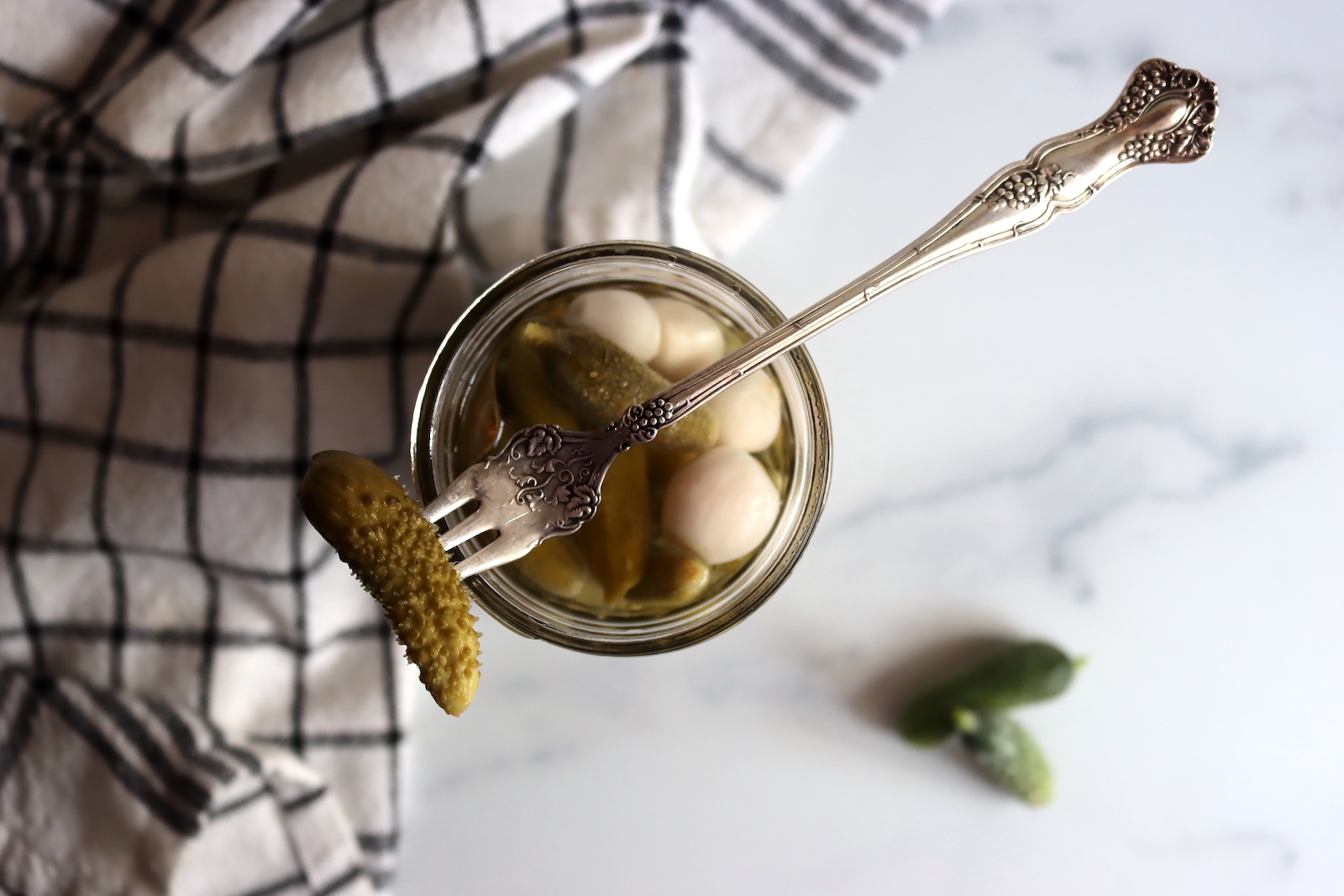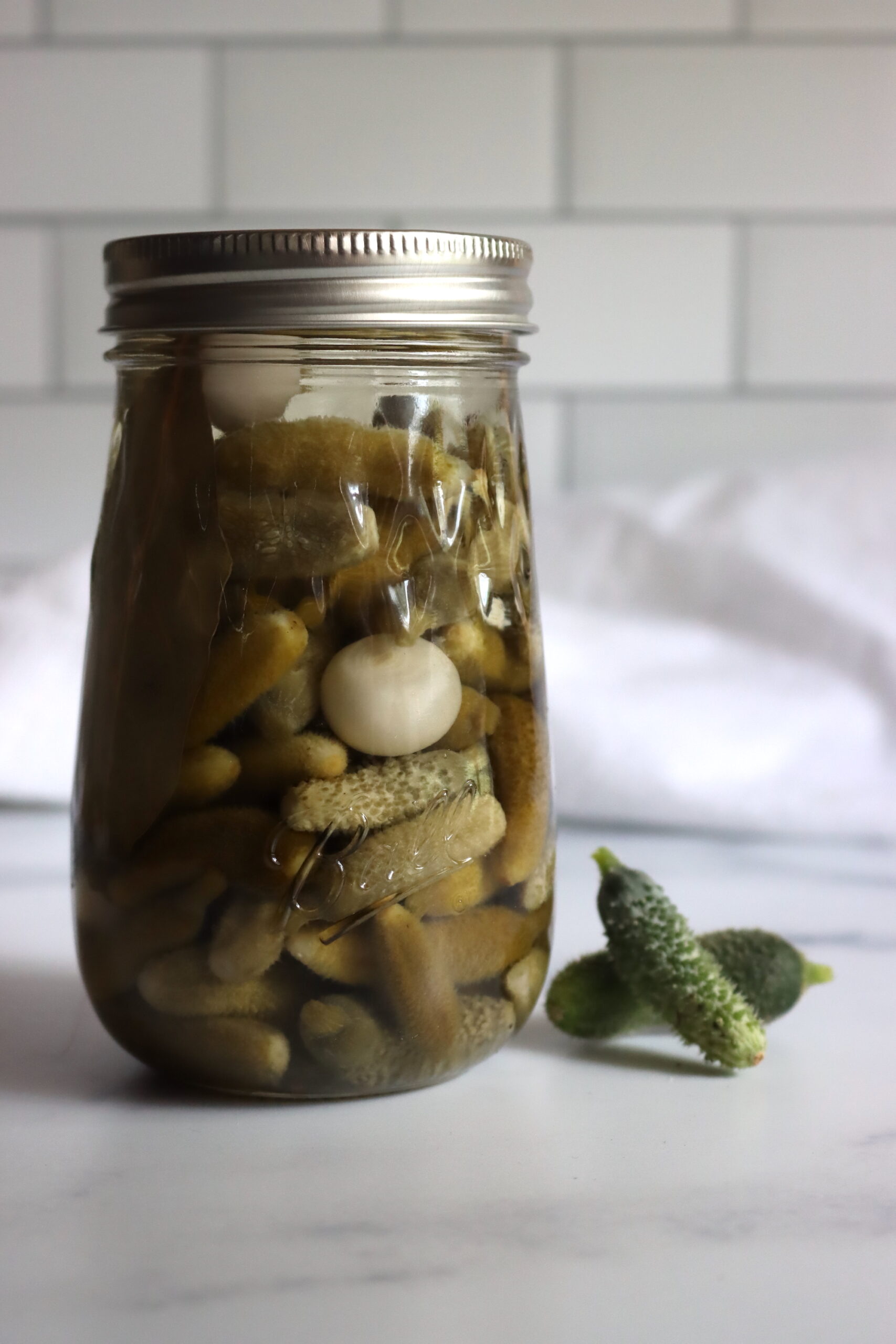Cornichons (or tiny baby pickles) are a traditional cucumber pickle from France, made with immature cucumbers that are only 1 to 1 1/2 inches long. These crunchy little pickles are perfect on a charcuterie plate, or anywhere you’d use a pickle.

Cornichons are small, tart pickles that hail from France. Though they’re commonly served alongside charcuterie and cheese boards, cornichons are a versatile and flavorful addition to just about any meal. With just the right amount of crunch and tang, these pickled delights can add a zesty kick to salads, sandwiches, and even cocktails.
So why are these little pickles so darn delicious?
It all comes down to their unique blend of flavors. Cornichons are made with a specific type of gherkin that is smaller and tangier than your average cucumber. They are then pickled in a mixture of vinegar, salt, and spices like mustard seed, dill, and coriander, which gives them their characteristic piquant taste.
But don’t just take our word for it. Try making your own cornichons and see for yourself why these pickles have been a beloved delicacy for centuries.

Canning your own cornichons is a fun and rewarding activity that allows you to customize the flavors to your liking. Plus, you’ll have a jar (or several) of delicious pickles on hand whenever a craving strikes.
The hardest part is finding very tiny cucumbers, which can be tricky unless you’re growing them yourself. Oftentimes, you can work with a farmer at a local farmer’s market, and they’ll give you their mini cucumbers for your project. Cucumbers often produce more than the plants can really support, and thinning the cucumber crop early on is one way to source these tiny little beauties.

Ingredients for Cornichons
This traditional recipe for French Cornichons was adapted from Saving the Season by Kevin West. He traveled to France and developed this preserving recipe in English based on his experiences there.
The ingredients for canning cornichons are quite simple. To make a canner batch of four pints, you’ll need the following:
- 2 lbs small cucumbers (gherkins – typically 3 inches or less in size)
- 10-12 individual cocktail onions, trimmed and peeled
- ¼ cup kosher salt
- 5″ branch tarragon
- 2 small bay leaves
- ½ tsp black peppercorns
- 2 tsp yellow mustard seeds
- 4 cups white wine vinegar
While you can use any vinegar that’s standardized to at least 5% acidity, I do really suggest opting for white wine vinegar. Apple cider vinegar gives them an earthy flavor that’s fine for bread and butters, but traditional cornichons want a clean finish. Similarly, distilled white vinegar isn’t right, as it’s too harsh. White wine vinegar gives them the perfect flavor.
Champagne vinegar will also work.

How to Make Cornichons
First things first, make sure you have all of your ingredients and equipment ready to go. Sterilize your jars, lids, and rings.
Next, wash your cucumbers and cut off a 1/16-inch slice off the blossom end. Make sure to leave ¼-inch of stem attached. Then, put your cucumbers in a large mixing bowl and add the kosher salt. Stir the gherkins well to coat them heavily. They’ll look as though they’re frosted!
Let them sit in a colander with the excess salt for about two hours. This will help them fully absorb the salt and become as flavorful as possible.
Beyond absorbing salt so they’ll be flavorful, this drives off extra water in the cucumbers, which makes them crisp. Without this step, your cornichons would be soggy and never develop the characteristic crisp tiny cucumber texture.

After two hours, rinse the gherkins with fresh water and pat them dry with a clean kitchen towel. This is important!
All that extra salt on the outside of the cucumbers should not go into the jars. It served a purpose, pulling out moisture from the cucumbers, but you don’t want them to be too salty. Be sure to rinse them well before proceeding.
Pack the gherkins into the sanitized pint jars, layering the onions, tarragon, and aromatics throughout. Try to distribute these as evenly as possible to make sure your flavors are consistent between the different jars.
Bring the vinegar to a boil on the stove, and then pour it over the cucumbers in the jars. Adjust the headspace, making sure you have at least ½” headspace at the top of the jars. Use a clean, damp rag to remove any residue from the rims of the jars.
At this point, if you’re simply making refrigerator pickles, allow the jars to cool completely and store them in the refrigerator. They’ll need to infuse for at least a week, preferably two, for full flavor.
If canning, instructions are below.

Canning Cornichons
The process for canning cornichons is no different than any other pickle.
Then, add the lids and bands to your jars. Load the jars into the water bath canner, then process for 10 minutes (for pints) in a boiling water bath. If you’re processing quarts, you’ll let them process for 15 minutes, adjusting for altitude for both sizes as needed. (Altitude adjustments are below)
When the time has finished, turn off the heat and allow the jars to remain in the canner for another fifteen minutes. Remove the jars, then let them cool on a rag for 24 hours at room temperature. Check the seals, label, and store. They should be good for at least one year in storage – if you can resist eating them that long!

Altitude Adjustments for Cornichons
Water boils at a lower temperature at higher altitudes, so jars need to be processed a bit longer as you go up in elevation. Here are the altitude adjustments for canning cornichons:
- For 0 to 1,000 Feet in Elevation – Process pint jars for 10 minutes, and quart jars for 15 minutes.
- For 1,001 to 6,000 Feet in Elevation – Process pint jars for 15 minutes, and quart jars for 20 minutes.
- Above 6,001 Feet in Elevation – Process pint jars for 20 minutes, and quart jars for 25 minutes.
Serving Cornichons
Here’s the best news – cornichons are ready to eat right out of the jar. No need to heat them up or add any extra ingredients – just crack open a jar and enjoy. They pair especially well with rich, creamy cheeses like brie or camembert, as well as cured meats like prosciutto or salami.
Feeling creative? Try chopping up some cornichons and adding them to your favorite tuna or egg salad for an extra punch of flavor. Or, dice them up and mix them with some sour cream and fresh herbs for a quick and easy dip that’s a fantastic crowd-pleaser at a party.
Now, if you want to really up your cornichon game, you might want to try breading and frying them for a crispy and addictive snack. Just dip each pickle in some beaten egg, then coat with a mixture of panko breadcrumbs and parmesan cheese. Fry in hot oil until golden brown and serve immediately.
And don’t forget about the refrigerator pickles option – these will last for a few months in the fridge and are just as delicious. Perfect for keeping a stash on hand for impromptu snacking or last-minute entertaining.

Traditional French Cornichons
Cornichons (or tiny baby pickles) are a traditional cucumber pickle from France, made with immature cucumbers that are only 1 to 1 1/2 inches long. These crunchy little pickles are perfect on a charcuterie plate, or anywhere you'd use a pickle.
Ingredients
- 2 lbs very small cucumbers (gherkins - typically 1 to 2 inches in size)
- 10-12 individual cocktail onions, trimmed and peeled
- ¼ cup kosher salt
- 5" branch tarragon
- 2 small bay leaves
- ½ tsp black peppercorns
- 2 tsp yellow mustard seeds
- 4 cups white wine vinegar
Instructions
- If canning, make sure you have all of your ingredients and equipment ready to go. Sterilize your jars, lids, and rings.
- Wash your cucumbers and cut off a 1/16-inch slice off the blossom end. Make sure to leave ¼-inch of stem attached.
- Put the cucumbers in a large mixing bowl and add the kosher salt. Stir the gherkins well to coat them heavily.
- Let the gherkins sit in a colander with the excess salt for two hours. This is essential, and it draws out extra moisture from the cucumbers so that they're crisp in the jar.
- Rinse the gherkins with fresh water and pat them dry with a clean kitchen towel. Be sure to rinse off all the extra salt, as they've absorbed just the perfect amount at this point, and you don't need the extra on the outside.
- Pack the gherkins into the sanitized pint jars, layering the onions, tarragon, and aromatics throughout.
- Bring the vinegar to a boil and then cover the cucumbers with the boiling vinegar, leaving 1/2 inch headspace.
- Add the lids and bands to your jars. If making refrigerator pickles, allow the jars to come to room temperature before storing them in the refrigerator. If canning, proceed to the instructions below.
- If canning, load the jars into the water bath canner, then process for 10 minutes (for pints) in a boiling water bath. Adjust for altitude as needed; see notes.
- Turn off the heat and allow the jars to remain in the canner for another five minutes (optional, but helps prevent thermal shock).
- Remove the jars, then let them cool on a rag for 24 hours at room temperature.
- Check the seals, label, and store.
Notes
Altitude Adjustments for Cornichons
Water boils at a lower temperature at higher altitudes, so jars need to be processed a bit longer as you go up in elevation. Here are the altitude adjustments for canning cornichons:
- For 0 to 1,000 Feet in Elevation - Process pint jars for 10 minutes, and quart jars for 15 minutes.
- For 1,001 to 6,000 Feet in Elevation - Process pint jars for 15 minutes, and quart jars for 20 minutes.
- Above 6,001 Feet in Elevation - Process pint jars for 20 minutes, and quart jars for 25 minutes.
If using jars smaller than a pint, the canning times are the same for as for pint jars.
Cucumber Pickle Recipes
There are a lot of ways to pickle a cucumber!
- Old Fashioned Lime Pickles (Cucumber pickles with pickling lime)
- Dill Pickle Chips
- Classic Dill Pickle Spears
- Bread and Butter Pickles
Vegetable Pickling Recipes
Put up a few more veggies with these vegetable-pickling recipes!
- Pickled Corn Salad
- Pickled Three Bean Salad
- Pickled Green Tomatoes
- Pickled Green Beans (Dilly Beans)
- Pickled Jalapenos
- Pickled Fiddleheads


Leave a Reply